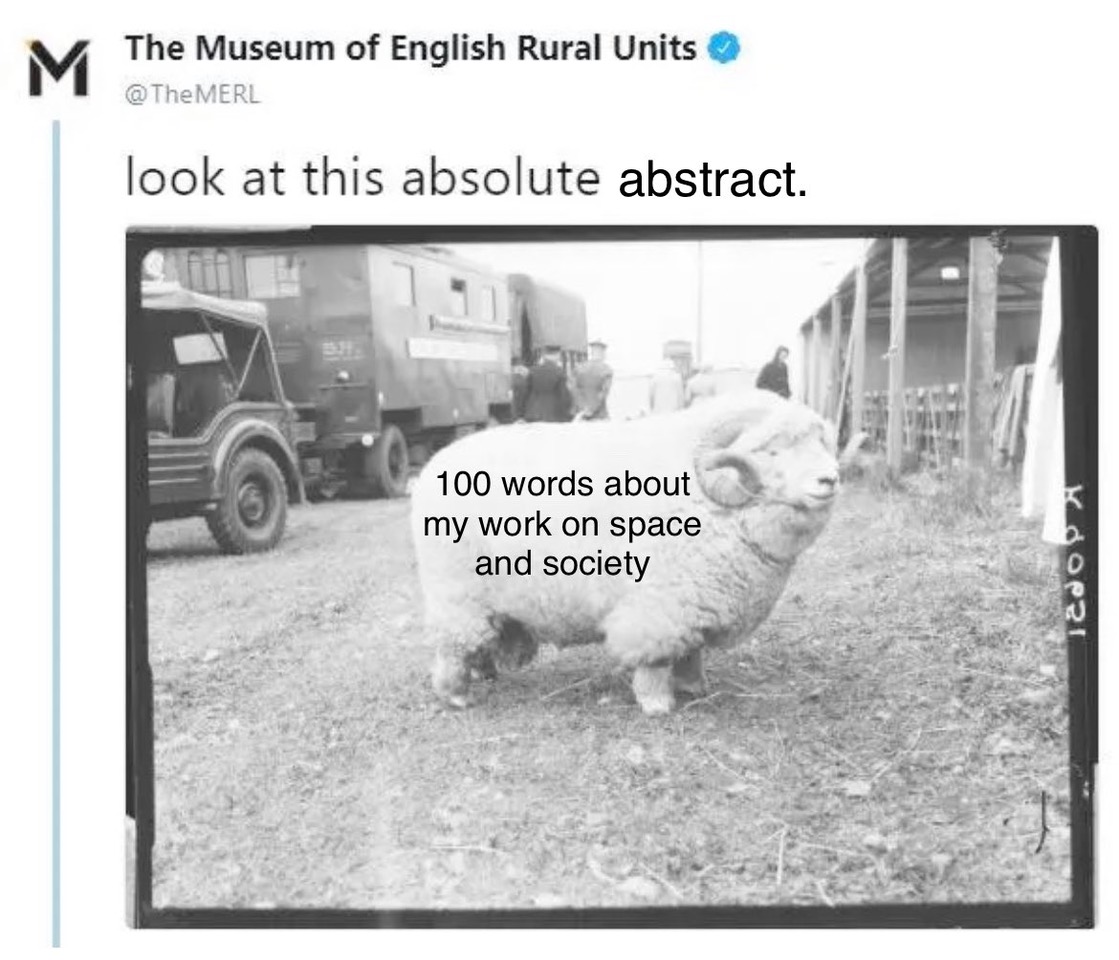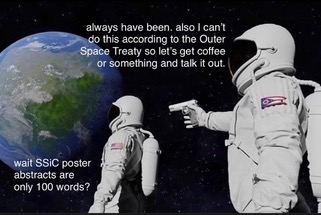Five reflections on co-organising Space Science in Context 2023
Eleanor S Armstrong & Divya M Persaud
04/24/2023 | Report-backs
In this Backchannels piece, we provide five reflections on our second Space Science in Context (SSiC) conference. SSiC is a multi-disciplinary conference, bringing together people interested in and who study outer space and/or its social contexts for an interactive event. In this text, we’ll be reflecting on organisation, accessibility, and community, and not the contents, of SSiC to engage wider discussions about what goes into conference organising as a praxis. SSiC 2023, like SSiC 2020, was fully virtual, with 418 registrants from over 50 different countries around the world, and was supported by a Royal Astronomical Society Meeting Grant and an EASST Fund Grant. Our content from both SSiC 2020 and SSiC 2023 remains available online.
-
Community is a labour of love
Eleanor S. Armstrong (ESA): Lots of people write back to us after SSiC to tell us how much they love the event’s community from across disciplines. What people who don’t participate in community-building might not realise is the time, effort, and energies that go into making these things a reality. Over the course of probably two years of organising this event, we spent around 500 hours on preparation (each!), and in the immediate 3 weeks leading up to the event this can be anything up to 6 hours a day troubleshooting the last bits. Community keeps me going as an academic and thank goodness, because it’s something that often goes un-rewarded in the academy at PhD/post-doctoral level.
Divya M. Persaud (DMP): Building community takes concentrated work. Whether you are broaching traumatic subjects or establishing an even ground for cross-disciplinary knowledge exchange, consent is important. Generating a structure for that consent is on the organisers: What power dynamics do you anticipate? How does the event structure generate different power dynamics? What structures can alleviate those power dynamics? We addressed these questions with our accessibility consultant and through our own research. It’s vital, as we make these spaces or purport to ‘build community,’ that we embrace the work that goes into that, and ensure that we centre the most vulnerable participants’ needs. When I say ‘work’ I also mean ‘money’ – and whose hands it enters.
-
People really appreciate the work we do to provide accessible content….
DMP: A lot of people have told us that SSiC was the first academic meeting where they felt safe and/or accommodated. So many, including myself, feel excluded by inaccessible content and formats, and/or pushed out by negative experiences (e.g., sexual harassment at networking events, lack of prayer rooms, lack of affordable registration or conference locations). When we got this feedback from SSiC 2020, it’s what drove me to say, “We have to do this again, and even better, because people need this.” It’s not just providing the space and content itself; it’s providing hope to so many communities that they have a place in academia, or science, or research, or knowledge. That’s priceless.
ESA: To develop an ‘accessible’ (and I use this in quotes because I don't think anything is perfect – certainly not SSiC!) event takes labour and money. Fundraising work can be tough as many budgets for events simply don’t have the monies in them for providing what is needed – from sign language, to live stenography, to rooms designated for uses such as prayer or breastfeeding. This is vital work, and it is vital work that deserves to be reflected in the kind of finances that are made available at institutions and through societies for organising events. I think it should also be reflected in the assessment criteria for such grants too, and it would be great to see structural changes in grant awarding criteria that prioritises awardees having more detailed access plans.
-
…but we work hard to make sure all the submissions match our accessibility guidance
ESA: If you want to be part of the change, then you have to actually be part of the change and do the work! Yes, it takes more time – but this time (and labour) certainly shouldn’t come only from those most needing these supports. That time often isn’t accounted for in either what we teach people it’s going to take to do a task like make a poster or a talk for a conference, or how we teach them to do it. Or what we (I) often budget into our own work. It’s almost like this labour is invisibilised within the academy…
DMP: Accessibility is a collective project, not a one-off accommodation at the individual level, and that’s a huge challenge in an academy structured around neoliberal logics of individualist inclusion. Many argue that disabled people have such hyper-individualist needs with little overlap, and so formulating an accessible course, event, etc. is almost impossible. This is not true and serves to pigeon-hole accessibility. With SSiC, we dared to make accessibility everyone’s issue—this requires buy-in, much like consent, which is really hard to get. The first step is admitting where you lack knowledge. The second step is to ensure that this work is funded and centres minoritised people—without exploitation.
-
Digital makes wonderful things happen
DMP: As a scholar who is disabled and immunocompromised, there is no question about the value of digital meetings and communities. The ‘buy-in’ isn’t a choice for me, nor for many peers. That said, it’s not a given—again, it takes work to build meaningfully across virtual platforms, just as it does in person. We spent a lot of time figuring out how to best work together and enable each other. Our networks also relied on digital communities, particularly because we wanted to reach beyond the pillars of academia—not just to centre the work of marginalised scholars and transgress borders, but also because the disciplines we bring together are very siloed. Direct messages powered much of SSiC. I was reaching out to astronomy clubs on Instagram.
ESA: Divya and I have only met in-person 4 times since we met in 2019 and I can hand-on-heart say digital technologies makes SSiC possible. When we first started planning our event (pre-pandemic, January 2020), we decided that the only way we’d be able to reach the kinds of audiences we wanted was to do things online. We use mailing lists, social media, a (at this point pretty hefty) cloud drive, a chat app, and a website to make SSiC. Digital is also the only way we could have navigated working now across so many different countries as each of us moved to for our short-term post-doctoral work between the UK, two coasts of the USA, and Sweden, as well as research travel and more. Community building on digital technology is where it’s at.
-
It is possible to do cool, interesting cross-disciplinary events!
ESA: One of the heartbeats of SSiC is cross-disciplinary communities. We intentionally make sure that we have speakers from many disciplines, that we advertise things across many different community focal points, and make explicit the norms of the event in a conference policy as they vary between different disciplines. One of the things with doing SSiC digitally is that no-one feels like they are the ‘visitor’ to someone’s department: that this is in fact a space for us all, equally. In SSiC 2023, we specifically looked out for ways to reach more natural scientists as they had been underrepresented in 2020, including seeking funding from organisations in both contexts to make the event legible to community members.
DMP: I’ve learned that embracing the weird, the (safely) discomfiting, and the challenging is how you learn. We had a ten-minute chat about poop at one of the panels and it was the most dynamic, gripping moment of the conference. There’s an energy you achieve, when everyone is at that level of buy-in and consent, and embrace, together, that we come from different expertise and geographies and whatnot, to have fun and truly engage. It’s a magic that left us wowed at these conferences—and has spun out into new collaborations, research, and art. When your speakers are open-mouthed at new information and the chat is on the fritz with people sharing cool papers or artworks and reacting with emojis to new information. There is something punk rock about having these cross-disciplinary spaces that are both vulnerable and massively creative. We need to challenge the ways the stationary or static at academic meetings stifles true learning.
This reflection is a part of two reports on the conference. You can read our comprehensive report on the conference in the forthcoming EASST Review.
Eleanor S Armstrong is a Postdoctoral Researcher at Stockholm University. She researches the social contexts of outer space and how we learn science in informal contexts. She is the co-organiser of Space Science in Context.
Divya M Persaud is a Research Fellow at University of Glasgow. She researches geology-driven imaging techniques and strategies for space technologies. She is the co-organiser of Space Science in Context.
Published: 04/24/2023



